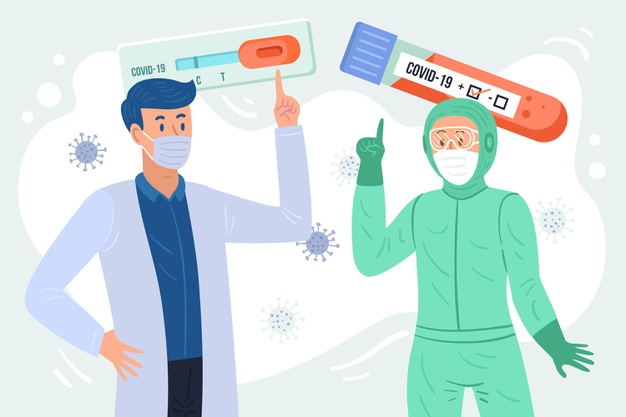
CONVALESCENT PLASMA THERAPY AGAINST COVID-19
June 24, 2020
RESEARCHERS OBSERVED RELATIONSHIP BETWEEN SLEEP TIMINGS AND CONGESTIVE HEART FAILURE
July 14, 2020In the current crisis of COVID-19 pandemic [COVID-19=Corona virus disease], two types of diagnostic tests are commonly advised by global healthcare systems for testing citizens for COVID-19.
Reverse transcriptase- Polymerase chain reaction [RT-PCR]
IgM and IgG enzyme-linked immunosorbent assay [ELISA]
Clear understanding of the nature of the tests and interpretation of their findings is of importance.

Reverse transcriptase- Polymerase chain reaction [RT-PCR]:


Thus far, the most commonly used and reliable test for the diagnosis of COVID-19 has been the RT-PCR test.
It is performed using nasopharyngeal swabs or other respiratory tract specimens, including throat swab or more recently saliva.
It is a very accurate test. It takes genetic material from the virus, target specific gene segment that only the virus have, and make large number of copies of those segments, i.e. it replicates those viral segments, so that they can be detected and measured.
In most individuals with COVID-19 infection, viral RNA in nasopharyngeal swab as measured by cycle threshold (ct) becomes detectable as early as day one of symptoms onset and peaks with in first week of illness. It can detect the infection in those individuals as well who are infected but asymptomatic.
[ ct is the number of the replication cycles required to produce a florescent signal. Lower ct values represents high viral load].
A ct value less than 40 is clinically reported as PCR positive.
In most of the patients PCR positivity starts to decline by week three and subsequently becomes undetectable.
However in severely ill hospitalized patients it may persists beyond three weeks, when most mild cases will yield a negative result.
A positive PCR result reflects only the detection of viral RNA and does not necessarily indicate presence of viable virus.
(Viable virus: virus which is able to cause disease or infection.)
[ When an individual gets infected with virus, he develops an immune response and overcomes the virus to the point that the virus is no more infective but sometimes PCR is still positive detecting for the presence of viral particles which are not viable and cannot cause any harm.]
A few cases have also been reported positive after two consecutive negative PCR results when performed 24 hours apart. It is unclear if this is a testing error, reinfection, or reactivation.
The time line of PCR positivity is different in specimens other than nasopharyngeal swab.
PCR positivity declines more slowly in sputum and stool samples, and may still be positive after the results of nasopharyngeal swabs are negative.
Usually, the clinical condition of the patients improves as nasopharyngeal specimens show negative results.
In a study of 205 patients with confirmed COVID-19 infection RT-PCR positivity was highest in bronco alveolar lavage specimen (93%), followed by sputum (72%), nasal swab (63%), and pharyngeal swab (32%).
False negative results mainly occurred due to inappropriate timing of sample collection in relation to illness onset, and deficiency in sampling techniques, especially of nasopharyngeal swabs.
DETECTION OF ANTIBODIES TO SARS-CoV-2 [IgM and IgG enzyme- linked immunosorbent assay (ELISA)]
COVID-19 infection can also be detected indirectly by measuring the host immune response to SARS-CoV-2 [Severe acute respiratory syndrome corona virus 2].
The immune system responds to the foreign proteins (virus, bacteria, [fungi, [toxins etc.) which are potentially harmful, by producing antibodies or immunoglobulins (y shaped protein molecules). These are present in the liquid part of the blood i.e. plasma. These antibodies attack the foreign proteins and trigger other immune responses which help the body to get rid of these foreign invaders.
These laboratory tests detect two main types of antibodies IgM and IgG in the serum of COVID-19 patients.
Usually the antibodies levels begin to increase from second week after the onset of symptoms.
Although IgM and IgG ELISA have been found to be positive even as early as the fourth day after symptom onset, higher levels occur in the second and third weeks of illness.
First IgM levels spikes as an immune response then as their levels are coming down IgG levels start spiking. Presence of IgG levels indicates that the individual has developed long lasting immunity against the virus.
These antibodies diagnostic tests could be helpful in identifying individuals who have developed immunity against COVID-19.
These tests can give researchers data about the prevalence of disease, and individuals who have recovered in the community as well.
Most of the available data is of adult population, who are not immunocompromised.
The time course of PCR positivity and seroconversion may vary in children and other groups including the large population of asymptomatic individuals, who go undiagnosed without active surveillance.
Many questions arise, particularly how long potential immunity lasts in individuals, both asymptomatic and symptomatic, who are infected with SARS-CoV-2.
REFERENCE:
Title of the article: Interpreting Diagnostic Tests for SARS-CoV-2
Authors: NandiniSethuraman, MD,
SundararajStanleyraj Jeremiah, MD
Akihide Ryo, MD, PhD
Published online : May 6, 2020
JAMA.2020;323(22):2249-2251.doi:10.1001/jama.2020.8259






